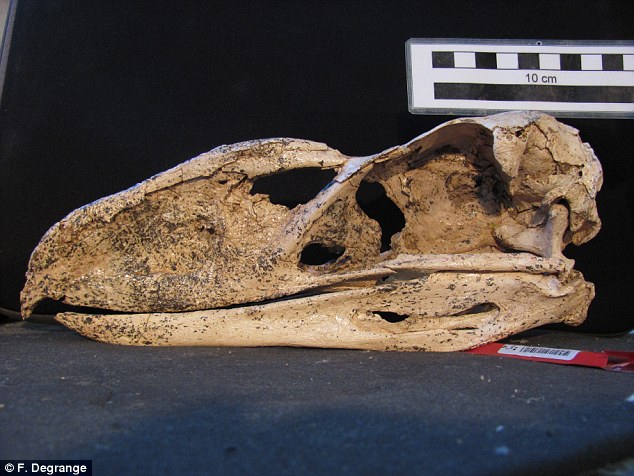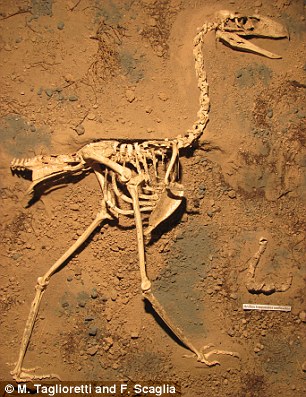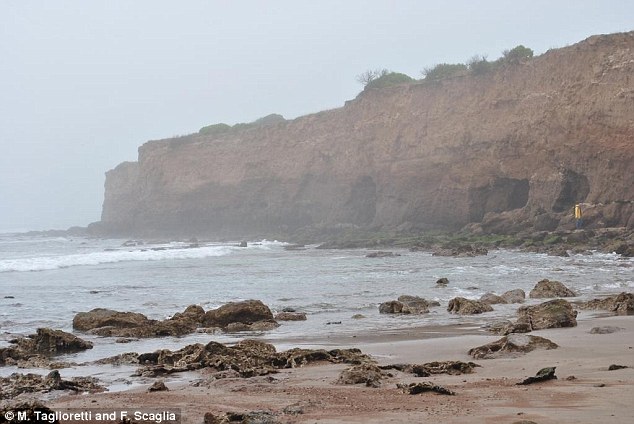fossilshk
(Lung)
管理員
  








UID 1
精華
23
積分 4670
帖子 2778
閱讀權限 200
註冊 2006-7-14
來自 中國/香港
狀態 離線
|
[廣告]:
Almost complete fossil of flightless predator discovered in Argentina
The skeleton of a new species of giant predatory bird that terrorised the Earth 3.5 million years ago has been discovered and is helping to reveal how these creatures would have sounded.
Palaeontologists say the four feet (1.2 metres) tall bird is the most complete skeletons of a 'terror bird' - a group of flightless prehistoric meat-eating birds - to be discovered.
The South American bird has been named Llallawavis scagliai - meaning Scaglia's Magnificent Bird after one of Argentina's famous naturalists Galileo Juan Scaglia.

Llallawavis scagliai (shown in the reconstruction above) would have had powerful jaws but limited hearing
It was so well preserved that scientists have been able to study part of the bird's auditory system and its trachae.
They say that while it had a terrifying apperance, its hearing was probably below average compared to birds living today.
They claim that the animal probably also had a limited vocal range that was quite low frequency.
It has also raised the prospect that the bird may have even used low frequency sounds to help detect its prey.
Dr Federico Degrange, a palaeontologist at the Centre for Research in Earth Sciences and the University of Córdoba in Argentina, said: 'The mean hearing estimated for this terror bird was below the average for living birds.
'This seems to indicate that Llallawavis may have had a narrow, low vocalization frequency range, presumably used for intraspecific acoustic communication or prey detection.'
Terror birds, or phorusracids as they are also known, were a group of carnivorous birds that grew up to 10 feet tall and had large hooked beaks.
They were the dominant predators in South America during the Cenozoic age which started with the extinction of the dinosaurs 65 million years ago.
Although smaller than some of the species discovered, Llallawavis scagliai, was one of the last terror birds to prowl the Earth before they died out around 2.5 million years ago.
It was discovered by Fernando Scaglia, from the Lorenzo Scaglia Municipal Museum of Natural Sciences, along with Matias Taglioretti and Alejandro Dondas at La Estafeta Beach south of Mar del Plata city in the Buenos Aires province of Argentina in 2010.

Scientists used 3D scanning of the long skull of Llallawavis scagliai (above) to examine its hearing ability
Dr Scaglia is the grandson of Galileo Juan Scaglia who was director of the museum between 1940 and 1980.
Due to incoming tides which were damaging the cliff, the team had to work quickly to excavate the entire fossil in one day.

The fossilised skeleton (above) was found in a cliff on a beach south of Mar del Plata city in Argentina
However, despite this they were able to retrieve a skeleton that is around 90 per cent complete.
In a study published in the Journal of Vertebrate Paleontology, the researchers were able to reconstruct the structure of the bird's inner ear using 3D computed tomography.
They found that Llallawavis would have had an average hearing range of around 3,800Hz and a sensitivity of around 2,300Hz.
The human ear, by contrast, can detect sounds with frequencies between 20Hz and 20,000Hz, but is best at around 4,000-5,000Hz.
This suggests that Llallawavis would have been better at detecting lower frequency sounds than humans are.
Dr Degrange told Mail Online the bird had a tracheobronchial syrinx - the structure that produces sound in birds - that was mainly made of cartilage and so it did not survived.
He said: 'It is not possible then through this to know exactly what kind of sounds terror birds were capable of produce.
'However, based on the hearing frequencies that we know that they were able to hear, it is possible to state that Llallawavis may have produced sound of low frequency.'
The researchers have also been able to better understand the some of the birds other features based on the palate and bones around the eye that were also preserved.
Dr Degrange said the bird would have had powerful muscles around its jaws but they were still conducting studies on the eyes to discover whether the bird was active during the day, at night or in the twilight hours.

La Estafeta Beach (above) near Mar del Plata in Argentina where the fossil was found has strong tides that threatened to wash the skeleton away forcing palaeontologists to work fast to excavate it to save it from harm
He said: 'The palate is a big area of jaw muscle attacment in birds. So, we are able to state how much developed were some of the jaw muscles in Llallawavis.
'The sclerotic ring will give us an idea of the eye shape and size. This will allow us to infer if terror birds were diurnal, nocturnal or crepuscular.'
He added that the fossil may also help scientists unpick what caused the giant birds to eventually die out.
He said: 'The discovery of this species reveals that terror birds were more diverse in the Pliocene than previously thought.
'It will allow us to review the hypothesis about the decline and extinction of this fascinating group of birds.'
Dr Claudia Tambussi, another author of the study at Argentina's Centre for Research in Earth Sciences, added: 'The discovery of this new species provides new insights for studying the anatomy and phylogeny of phorusrhacids and a better understanding of this group's diversification.'
http://www.dailymail.co.uk/scien ... ered-Argentina.html
| 
 |
|





